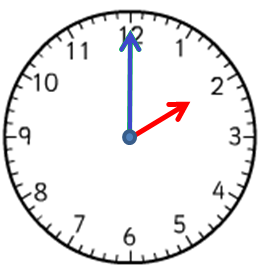In this activity, we are going to be converting time from an analogue clock (12-hour clock) to a digital clock (24 hours).
Things we need to know:
There are 24 hours in one whole day.
Day and night are divided into a.m. (through the night from midnight until lunchtime) and p.m. (12 noon until midnight).
Digital clocks tell time over 24 hours from 00:00 to 23:59 - we often use digital clocks and watches to tell the time.
We add 12 hours to times after 12 noon (p.m.) to convert analogue time to digital: 2 p.m. = 2 + 12 = 14. We write this as 14:00
Here is an analogue clock:

The red hand tells us the hour and the blue hand tells us the minutes.
On this clock, the long blue hand is pointing straight up to the 12. This tells us that the time is something o'clock.
The short red hand is pointing to the 2. This tells us that it is 2 o'clock.
2 a.m. (the middle of the night) is written as 02:00 on a digital clock.
Did you notice the colon symbol (:) between the digits? We always include this.
2 p.m. (after lunch) is written 14:00 on a digital clock (2 + 12 = 14)
Here is a digital clock:

The 10 tells us that the hour is 10. The 15 tells us the minutes (15 minutes past the hour).
The time is 10:15 a.m. (remember that times after 12:00 are p.m. times)
In the following questions, we are just going to convert times that are o'clock times.
Right, let's get started on the questions now!









